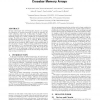Free Online Productivity Tools
i2Speak
i2Symbol
i2OCR
iTex2Img
iWeb2Print
iWeb2Shot
i2Type
iPdf2Split
iPdf2Merge
i2Bopomofo
i2Arabic
i2Style
i2Image
i2PDF
iLatex2Rtf
Sci2ools
ICCAD
2007
IEEE
2007
IEEE
Fault-tolerant multi-level logic decoder for nanoscale crossbar memory arrays
Several technologies with sub-lithographic features are targeting the fabrication of crossbar memories in which the nanowire decoder is playing a major role. In this paper, we suggest a way to reduce the decoder size and keep it defect tolerant by using multiple threshold voltages (VT), which is enabled by our underlying technology. We define two types of multi-valued decoders and model the defects they undergo due to the VT variation. Multi-valued hot decoders yield better area saving than n-ary reflexive codes (NRC), and under severe conditions, NRC enables a non-vanishing part of the code space to recover. There are many combinations of decoder type and number of VT’s yielding equal effective memory capacities. The optimal choice saves area up to 24%. We also show that the precision of the addressing voltages for decoders with unreliable VT’s is a crucial parameter for the decoder design and permits large savings in memory area.
| Added | 16 Mar 2010 |
| Updated | 16 Mar 2010 |
| Type | Conference |
| Year | 2007 |
| Where | ICCAD |
| Authors | M. Haykel Ben Jamaa, Kirsten E. Moselund, David Atienza, Didier Bouvet, Adrian M. Ionescu, Yusuf Leblebici, Giovanni De Micheli |
Comments (0)

